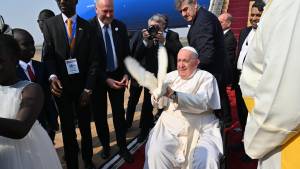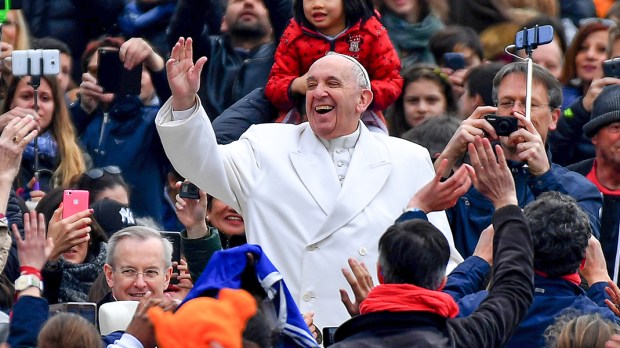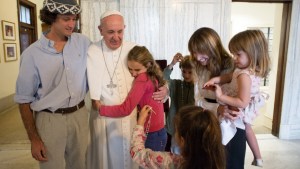Since his election in 2013, Francis has left a very personal mark on the way the Holy See conveys its message to the “City and the World.” His communication, capable of arousing the interest of non-Christians as well as stirring up stadiums full of the faithful, has greatly expanded the reach of the papal “word,” but has also sometimes caused confusion within the Church.
In his first interview in 2013 with Fr. Antonio Spadaro, the influential director of the Jesuit magazine La Civilta Cattolica, Pope Francis testified to the difficulty his new “job” presented for him: “I’m able to look at individual people, one by one, to connect in a personal way with those before me. I’m not used to the masses.”
What he described then as one of his weaknesses has turned out, 10 years later, to be one of his greatest strengths. The Argentine pontiff has kept his style simple, close to natural conversation in his speeches, and visual and accessible in the texts of his magisterium. Reputedly austere in Buenos Aires, he has proven to be jovial in Rome. His good-naturedness has often led to comparisons with the “good Pope” John XXIII.
After Benedict XVI’s pontificate, marked by his concise language as a rigorous theologian, the verve of Francis, adept at improvisations and spontaneous reactions, and often humorous or emotional, has caught the attention of many.
Often disregarding etiquette, the Pope has built his communication on establishing an “informal closeness” with his interlocutors. “Don’t forget, please, to pray for me,” he asks tirelessly after each speech. This phrase, the most heard in the last 10 years, is characteristic of the care the Pope takes to establish a real link with his audience. This “bridge” that he builds between himself and each speaker seems to be human before it is magisterial.
Communicating: between gesture and silence
Colombian researcher Ary Waldir Ramos Diaz notes in his book, “Be authentic! Pope Francis’ keys for interpersonal communication,” (“¡Sed auténticos! Claves del papa Francisco para la comunicación interpersonal”, not yet available in English) that Francis communicates first “through actions” because they are a “universal language.”
In his South American style, the Pope regularly speaks of the “caresses” that must be given to a suffering world, and that God gives to us.
Archbishop Guido Marini, the Pope’s former master of ceremonies, said in an interview published in 2021 that Francis is a “genius of stagecraft.” The Italian assisted the Pontiff at the Statio Orbis on March 27, 2020, a ceremony during which the Pope prayed for the world, which at that point had been plunged into the chaos of the pandemic. More than his speech that evening, it was the solitude of a pope in a storm-ridden St. Peter’s Square that many remember.
A critic of gossip, Pope Francis considers that “the world is sick of noise” and praises the merits of “silent presence,” an indispensable step in listening to others. This is a principle that he has tried to deploy in his diplomacy, which is very active in promoting dialogue for peace in many countries of the world. But this is also the case in the ecclesial realm with the synod on the future of the Church, launched in 2021, which aims to revive a culture of synodality, that is, the art of listening to one another in order to move forward despite differences.

An unpredictable word
As a reformer, Pope Francis has continued the modernization, in particular using the latest technology for the Holy See’s communications, begun by his predecessor. Although he has regularly been very critical of the risks of virtual communication, he has nevertheless opened an Instagram account and launched a prayer application – Click to Pray. He has also received in the Vatican top executives of the “Big Five” of the tech world (Alphabet (Google), Amazon, Meta (Facebook), Apple, and Microsoft). On Twitter, his accounts – published in many languages – have exceeded 45 million followers.
Francis has also thoroughly restructured the communication of the Curia by creating, in 2015, the Dicastery for Communication, in which he brought together all the media entities of the Vatican: Vatican News, Vatican Radio, L’Osservatore Romano (which he nicknamed the “Pravda”), the Press Office of the Holy See, the Vatican Publishing House, etc. His stated goal is greater efficiency, less spending, and focusing action on the proclamation of the Gospel.
But the Pontiff has also shown himself to be very distant from his own administration, often bypassing the official channels of communication of the Holy See – notably his Press Office – in favor of his own networks, which are much more elusive and unpredictable.
In 2021 the Pontiff publicly criticized Vatican communications during a visit to Vatican Radio. The pope’s injunctions to take initiative, while the structures he has established tend to limit freedom of action, revealed the fundamental problems within Vatican communications.
Unlike his two predecessors, who could rely fully on their spokespersons, this pontiff wanted to be in control of all his communication so as not to see his words used by power groups acting for their interests within the Church. Thus, Matteo Bruni, the current director of the Press Office, does not act as his spokesperson.
Free communication
Although he grants many interviews in which he does not close the door to any subject, the Pontiff often does not go where his interlocutor wants to take him. “The pope doesn’t always answer the questions he is asked,” notes sociologist Dominique Wolton, who conducted 12 interviews with the Pontiff, published in the book “The Path to Change: Thoughts on Politics and Society.”
This ability of the Pope to take the opposite tack of his interlocutor has been particularly observable during the press conferences organized on each return flight – and no longer on the outbound flight, as in the two previous pontificates – of his trips abroad. The Argentine pontiff has restored the importance of this moment of privileged contact with the press, which Benedict XVI had “locked down” in the middle of his pontificate after a controversy over the use of condoms.
During the 40 return flights over the past 10 years, Francis has again allowed journalists to ask questions freely on all topics. He has expressed himself in a very spontaneous but often unrestrained style.

“Borders” and divisions
Pope Francis’ spontaneity has sometimes worked against him, however, such as when he got confused in his remarks about the resignation of Archbishop Aupetit of Paris, or when he undermined his own diplomatic efforts by suggesting that Buryats and Chechens were responsible for the massacres in Ukraine.
The Pontiff’s style of communication has also regularly caused perplexity and even anger in his own ranks. “You are more loved […] by atheists than by Catholics,” Dominique Wolton remarked.
In the Church, some voices have frequently reproached the Pope for a form of “populism” that blurs the lines on doctrine. Others, on the contrary, have been annoyed by his “pastoral” style, which they believe has prevented him from initiating the major reforms they expect of him.
Pope Francis, for his part, has repeatedly spoken out against what he describes as “polarization.” Against binary ideological conflicts, he has encouraged Christians to enrich their communion with the differences of opinion and perspective that exist in the Church, making this challenge one of the axes of the great process of the synod on the future of the Church launched in 2021.


